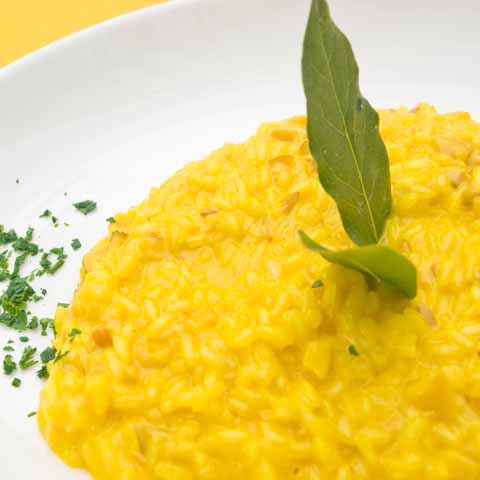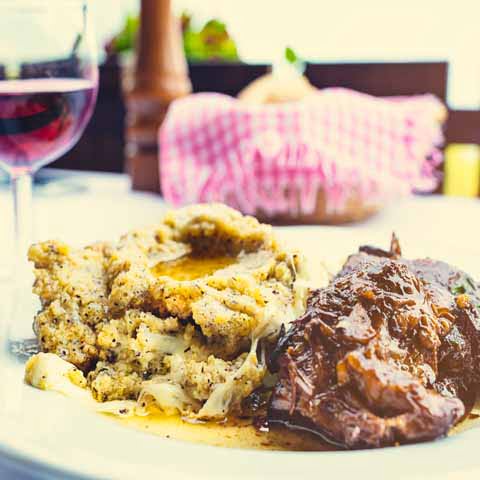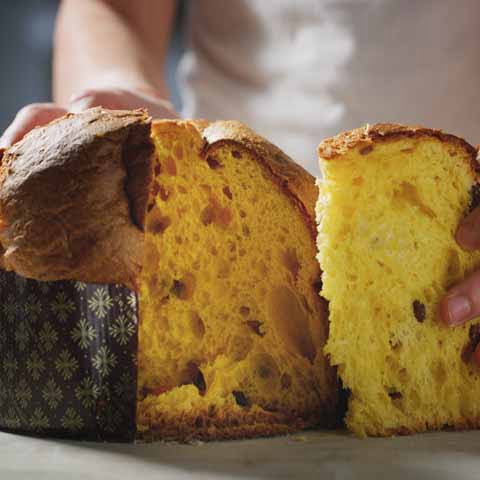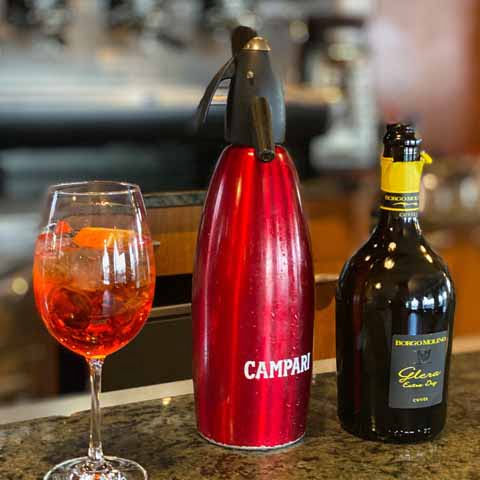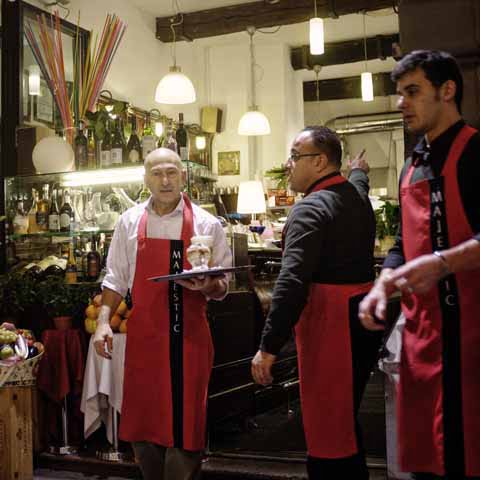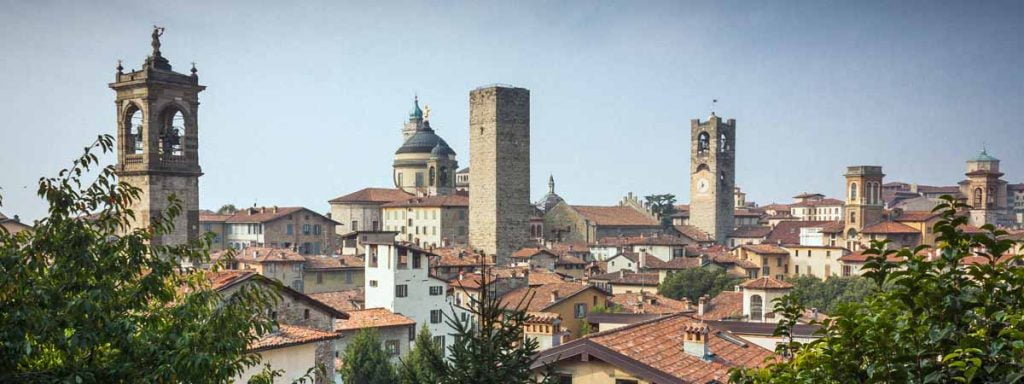Milan’s cuisine is known for its richness in both international diversity and unique flavors. While typically overshadowed by other Italian food cities such as Bologna and Rome, Milan has found its own way to stand out in the culinary world – even choosing to focus on food when hosting the 2015 World Expo. The theme of the event was “Feeding the Planet, Energy for Life.”
Geographically, the city is located in the center of Northern Italy in the region of Lombardy. It is nestled between the Po River to the south and the foothills of the Alps to the north, with the Tincino and Adda rivers to its west and east, respectively. This location in the Po Valley has impacted Milan’s cuisine throughout the centuries. Once at the center of agriculture and trade along the rivers, the waterways were impacted greatly with the growth of land development during the 19th century. Today, the city has protected agricultural land in order to maintain the presence of local products.
Traditionally, seafood is largely absent from Milanese menus due to its distance from coastal waters (one exception is river shrimp, which at one time was prevalent in the city’s canals, though today it is no longer present). However, it is interesting to note that Milan is one of the most important commercial fish distribution centers in Italy. Every day fresh fish from national and international shores arrives at Milan’s fish market, and from there it is distributed throughout the regions of Italy.
While in Milan, visitors will find hearty and flavorful options on the menu. Important ingredients in Milanese cuisine include meats – such as veal and pork – cheeses, and rice. The pastas and tomatoes seen throughout other regions of Italy are present in Milan, but not as prominent. In addition, compared to Southern Italy, butter is used more often for the added flavor.
The city’s cuisine is deeply rooted in the region’s history. Through the ages the Spanish, Austrians, and French were among those ruling Milan – therefore it comes as no surprise that a bit of their own culinary dishes and traditions were left behind. While customary dishes are emblematic of the city’s cuisine, visitors will also discover the vast diversity in the available food as Milan’s cuisine is a reflection of the city’s international ties.
APPETIZER
The tradition of the aperitivo began in Northern Italy, and Milan is believed to be the best place to experience it. Similar to the American “Happy Hour,” aperitivi are a popular pre-dinner event in local bars and high-end restaurants alike, featuring drinks accompanied by small plates. The ambiance and surrounding company are just as important as the food. During aperitivo, customers purchase a cocktail or glass of wine and this gives them access to a buffet of finger foods or a complimentary tray with snacks brought to the table with the drink.
A typical aperitivo tends to feature olives, chips, crostini, spreads, nuts, and, of course, a selection of quality cold cuts and cheeses. As part of their aperitivo buffet, some restaurants offer heartier options including small panini, mini calzones, and squares of pizza. Though the traditional aperitivo is meant to anticipate dinner, not to replace it, in the past few years some Milanese restaurants have started offering an apericena, which is a sort of mix between aperitivo and dinner. In addition to the snack foods present during aperitivi, an apericena will also feature small portions of richer foods featuring pasta, rice, and vegetables. Apericene last longer than aperitivi and offer more food for those looking to make a meal out of the visit and substitute their dinner.
Outside of the aperitivo, dinner in Milan usually begins with a light appetizer featuring cured meats and cheeses. Historically, the Milanese would enjoy cheese at the end of the meal, though nowadays it is served at the beginning with cured meats or on its own as a side dish (see side dish section below). Traditional cured meats in Milan include salame (salame Milano in particular, which is made from pork, beef, pepper and spices), prosciutto crudo, salame cotto, spalla cotta, and prosciutto cotto.
Several of Milan’s historic small plates are now served during the appetizer such as insalata di nervetti (thinly sliced veal tendon that is poached in a light broth and served with onions, beans, and parsley), giardiniera (pickled local vegetables such as peppers, carrots, green beans, onions, and celery), and salted anchovies (desalted and served with butter and bread).
FIRST COURSE
After enjoying a spread of appetizers, the first course in Milan comes with the richness expected from the local cuisine. One of the city’s most well-known dishes is the risotto alla milanese – a dish that reflects Milan’s position as one of Italy’s prosperous cities. The most expensive spice in the world – saffron – is used to create a rice dish unlike any other. What starts as a creamy blend of rice, onion, and beef broth is given a bright yellow color and a distinctive aroma and flavor when saffron is added. Finished off with butter and Grana Padano cheese, this creamy and fragrant dish is a must-try during any visit to Milan. Risotto alla milanese is often served on its own, though traditionally it was always served with veal shank (ossobuco), and the marrow from the shank would be placed on top of the risotto. This risotto may also be served with other meats or with fish, such as perch fried in butter and sage.
Risotto alla milanese is the city’s traditional risotto dish, though a variety of risotti can be enjoyed in Milan featuring different local ingredients. A few common examples that may be served depending on the season include risotto with squash, gorgonzola, tomato, mushrooms, nettles, asparagus, shrimp, beans, or wine.
In the autumn and winter, soups feature prominently among Milan’s first course offerings. Stuffed pasta and egg-based pasta are often served in broth. One common example is ravioli, which may be filled with ricotta and spinach or with beef and served in a rich broth. Pancotto is another soup featuring stale bread that may be boiled in water, milk, or broth.
Vegetable soups are common as well, with minestrone being another local favorite. While minestrone is enjoyed throughout Italy, Milan offers a distinct variation known as minestrone alla milanese. Originating among the peasant population, the soup was traditionally cooked slowly for several hours and featured ingredients that were commonly found in the local plains. The soup is usually made with butter, potatoes, celery, beans, green beans, cabbage, leek, carrots, zucchini, and tomatoes. Rice or small pasta is often added as well. The final touch is always a generous grating of Grana Padano. Minestrone in Milan is served hot, though it can also be served the day after preparation and in this case it is cold.
Often featured in minestrone, rice is a staple of local soups and may also be prepared with other ingredients such as beans, parsley, potatoes, squash, turnips, asparagus, and tomatoes.
SECOND COURSE
The second course of Milanese cuisine is similar to the rest of Italy in that the dishes contain the meat of the meal. A famous dish out of Milan is ossobuco alla milanese – made using cross-cut veal shanks. The meat is floured and briefly seared, then cooked for about an hour and a half with onions, carrots, celery, tomato, broth, and white wine. Ossobuco is usually topped with gremolada, which consists of finely chopped parsley, garlic, rosemary, and lemon zest. The flavorful bone marrow is the highlight of this dish and is traditionally dug out with a small spoon or knife and spread on bread in place of butter, or on accompanying risotto alla milanese. The shanks may be served on their own, but they are often served atop risotto or polenta.
Another popular dish to try while in Milan is cotoletta alla milanese – the original schnitzel. According to the locals, this dish was prepared in Milan long before the arrival of the Austrians as evidenced by a document from 1148 that refers to lumbulus cum panitio, breaded veal loins.
In Milan, the veal is kept on the bone and the cut should be thick, but less thick than the bone so that, if cooked properly, the interior of the meat remains tender and creates a nice contrast between the crunchy surface. It is then breaded and fried in butter (clarified butter if possible) to a crispy golden brown. One common variation served by Milanese restaurants is called orecchia d’elefante (elephant ear), and in this case the cutlet is pounded until it is very thin and quite large (in some cases up to 15 inches).
While Milan is known for its luxury, more modest dishes such as cassoeula can be found on most menus. This peasant casserole is traditionally made up of cabbage and leftover pork parts such as the rind, snout, feet, head, ribs, ears, and sausage. This classic winter dish is cooked in stages with a quick cooking time for the ribs and sausage, and a longer cooking time for the tougher organ meats. The cabbage is added towards the end and some include a small amount of tomato paste only to add a bit of color. Cassoeula is traditionally served with soft and creamy polenta.
Mondeghili are unique meatballs born out of the peasant tradition that nothing should go to waste. Traditionally, the meatballs were made from previously braised or boiled meat that was minced and mixed together with stale bread plus whatever ingredients were on hand, such as sausage, cabbage, salame, mortadella, and Grana Padano. Today it is common to simply use ground beef mixed with eggs, breadcrumbs, and Grana Padano, but the preparation remains the same. Once the meatballs are formed, they are lightly flattened then coated with breadcrumbs and fried in butter. In some cases, the meat may be cooked and then ground before forming into meatballs, which is more in line with the original recipe, though both versions are accepted today. Mondeghili are often served with potatoes or a salad. Modern preparations may feature the meatballs served in tomato sauce, though this is a newer practice and not very traditional.
Another highlight of Milan’s humble peasant cooking is trippa alla milanese or busecca (tripe). Many different parts of Italy prepare their own versions of tripe. In Milan, this dish has a consistency similar to soup and features sliced veal tripe sauteed in butter, lard, carrots, celery, and sage. After sautéing, water is added along with tomatoes and borlotti beans. The mixture is left to cook over low heat for approximately two and a half hours. The dish is served hot with plenty of grated cheese on top.
Rostin negàa or rustin negàa is a traditional Milanese dish that features rolls of veal tied with twine. The veal is covered with flour then seared in butter (sometimes butter with sage or butter with pancetta). Afterwards, it is simmered in white wine and cooked in broth over low heat. The veal is said to be “drowned” in the wine, an allusion to the dish’s name which translates to “bites of roasted meat that are drowned.”
Milan also has its own variation of bollito misto, known as bollito misto alla milanese, a beef stew that is prominent in the Po Valley, particularly in Piedmont. In Milan, the dish features poached beef, veal and cappon served with boiled vegetables, cotechino (cooked separately), mostarda (candied fruit in syrup), and three sauces (a green sauce made with parsley, oil, and anchovies, plus a red sauce made with tomatoes, bell peppers, and carrots, and a yellow sauce made with egg yolks, lemon juice, flour, and sugar). The broth that results from bollito misto is often used to make risotto, ossobuco, rostin negàa, or it can be served with ravioli.
Brasato alla milanese is another variant of a typically Piedmontese dish, brasato al Barolo (meat that is slowly cooked in Barolo wine). In Milan, the Barolo is substituted with Valtellina Superiore DOCG or another full-bodied local wine. In addition, peeled tomatoes and broth are added to the cooking liquid. The dish is served with polenta that is usually prepared with taleggio or gorgonzola cheese.
Lastly, fritto misto is a dish that is common throughout Italy and it usually features local fish or seafood. In Milan, fritto misto alla milanese is prepared with veal offal, typically brain, liver, and sweetbread. The fried meat may be served with fried vegetables such as zucchini, eggplants, and mushrooms. To prepare the dish, the offal is boiled then breaded and fried in butter. As with other fried foods throughout Italy, fritto misto alla milanese may be seasoned with lemon juice.
SIDES & CONDIMENTS
Alongside any meal in Milan are sides and condiments unique to the region. The Po Valley was nicknamed the “rice bowl” of Italy due to the abundance of rice grown there. As a result, grains such as risotto and polenta are more prominent in the city’s cuisine than pasta.
Polenta is an adaptable side dish, made up of cornmeal and water and traditionally cooked to a thick, creamy consistency. Polenta can also be part of a piatto unico (main course) if served with meat. In Milan, it is easy to find polenta prepared in several different ways, just like everywhere else in Northern Italy. Common preparations of polenta include plain polenta, fried polenta, polenta with milk, polenta with cheese (usually gorgonzola or taleggio), and polenta pasticciata (served with butter, sausage, Grana Padano, and mushrooms).
In Milan, cheese can be found as a side, appetizer, condiment, or even as part of desserts. The area around Milan is home to some of the tastiest Italian cheeses such as:
• Gorgonzola
• Grana Padano
• Mascarpone
Originating from Gorgonzola, a town in the metropolitan city of Milan, gorgonzola is made from cow’s milk and appears pale yellow or white with blue-green veins. First produced as early as 879 A.D., it comes in two types – dolce and piccante. Dolce is soft and creamy, while the piccante is thick and crumbly with a sharp, almost spicy tone. Both types are PDO, or Protected Designation of Origin products. Gorgonzola goes well atop meats, rice and pasta.
Grana Padano, produced throughout the Po River Valley, is a hard cheese made from cow’s milk. Production can be traced back to the twelfth century at the Chiaravalle Abbey, which is approximately five miles south of Milan. Grana Padano is also a PDO cheese and it is produced in a similar manner to Parmigiano-Reggiano, yet the production area is much larger and the regulations surrounding production are less strict compared to Parmigiano-Reggiano. Notably, Grana Padano is the number one cheese in Italy in terms of production volume, and it is the most widely exported Italian cheese.
Mascarpone is native to the area just southwest of Milan, particularly in the cities of Lodi and Abbiategrasso. This soft cheese is created from curdled cream and citric acid. The resulting cheese is creamy and thick and should be tried in both savory and sweet recipes.
Several other PDO cheeses are commonly produced in the area around Milan, including provolone Valpadana (an aged, stretched-curd cheese with a semi-hard consistency), taleggio (a soft cow’s milk cheese with a strong aroma and thin crust), and stracchino (soft, creamy cheese with a subtle flavor). Generally speaking, Milanese restaurants tend to feature a variety of cheeses produced throughout the Lombardy region.
Cheese is usually served on its own, or it may be spread on bread (one type of local bread is called micchetta, which is a small, star-shaped loaf). Cheese produced in Lombardy (typically taleggio or gorgonzola) is commonly added to polenta.
Like in the rest of Italy, Milanese side dishes typically feature local vegetables. In this part of Italy vegetables are usually boiled or fried. One example is apsaragi alla milanese, which are served with eggs, butter and grated cheese.
As for condiments, pancetta or lard are often added to vegetable minestrone to make the dish heartier. Cream is also a common addition to salad bases or sauces, while most salads are finished off with olive oil.
DESSERT
A meal in Milan would not be complete without trying one of the city’s traditional desserts. By far, Milan’s most famous dessert is panettone – a sweet bread filled with raisins and candied fruits that is shaped into a dome. The light and fluffy dough consists of yeast, butter, eggs, and flour. Dating back to the fifteenth century, this soft and elegant cake has always been associated with Christmas. At one time, panettone was a Milanese exclusive, but it has since spread throughout the rest of Italy and the world, becoming a symbol of Italy’s Christmas traditions.
Also important during the Christmas holidays in Milan, though not very well known outside of the city, is veneziana. During Christmastime, veneziana has a size and shape similar to panettone with a dough made from butter, flour, and yeast. Candied orange is often added to the filling, while the top is usually covered with an almond glaze and/or white sprinkles. During other parts of the year, smaller versions of veneziana can be purchased in Milan. These are intended as a single serving and may be enjoyed for breakfast accompanied by a cappuccino. Smaller and simpler than the Christmas version, these veneziane have a round shape and are usually topped with white sprinkles as well.
Another local dessert is colomba – a dove-shaped cake created from flour, sugar, yeast, butter, eggs, and candied citrus peels, and topped with almonds and white sprinkles. Invented in Milan during the twentieth century to celebrate the Easter holiday, the colomba eventually spread to other regions and is now enjoyed each Easter throughout Italy.
There are also two chestnut-based local desserts that are enjoyed in autumn. The first is busecchina, and it is made from dried chestnuts that are slowly boiled overnight. Towards the end of the cooking time, a glass of sweet wine is added. The chestnuts are served lukewarm and soaked in heavy cream or topped with whipped cream. The second is castagnaccio milanese, which is a crumbly chestnut cake, and variations can be found in other parts of Italy as well.
Cakes are prominent in the local cuisine as well, with meneghina and bertolda being two excellent examples. Both cakes are baked in a sheet pan with the former made from eggs, flour, hazelnut flour, yeast, sugar, milk, and apple slices, while the latter is made from flour, eggs, butter, milk, yeast, and lemon zest.
Charlotte alla milanese is a dessert representing the city’s peasant cuisine. Made from apples, sugar, lemon zest, raisins, candied fruits, and stale bread, this dessert may be served warm in the winter or cold during warmer parts of the year.
Another delicacy is pan meino, a yellow bread, similar to a sweet version of focaccia made from flour, butter, eggs, sugar, elderflower, and topped with powdered sugar.
STREET FOOD
Getting a quick bite to eat while seeing the sights of Milan is easy as the number of street food vendors is on the rise. Food trucks are dispersed throughout the city representing a variety of international cuisines. Still, the best foods to try are the classic Milanese offerings.
Milan’s most legendary street food, the panzerotto, actually originates from the Puglia region in Southern Italy. These heavenly treats consist of dough that is stuffed with a variety of ingredients from the classic tomato and mozzarella to ham and mozzarella, spinach and ricotta, and much more. There are sweet options available as well featuring many different fruits and sweet sauces. Served either fried (the most popular option) or oven baked, savory and sweet panzerotti are the perfect snack for exploring the Duomo area.
There are also a few shops that specialize in certain types of foods that are prepared specifically to enjoy on the go. One example is ravioli, which are available in a variety of fillings, and another is fried foods, such as chicken, seafood, and vegetables, that are served with sauces and wood skewers for portability.
When the weather gets colder, the aroma of roasted chestnuts fills the air. If you are planning to visit Milan in the winter, do not miss your chance to purchase caldarroste (roasted chestnuts) from one of the city’s street cart vendors.
WINE
Italian meals are not complete without a splash of local wine, and Milan is no exception. While the Lombardy area of Northern Italy lacks in coastal cooling, the nearby lakes provide the mild climate that keeps wine producers in business.
The two wines at the forefront of the region’s selection are the sparkling white wines produced in the Oltrepo Pavese and Franciacorta areas of Lombardy, as well as the red wine out of the Valtellina area. The sparkling wines are a favorite with various styles to choose from, including a dry Buttafuoco, passito dessert wine, and the sparkling varieties, such as Franciacorta. Visitors will also find white and rosé varieties on the menu, with a number of wines designated as DOC, DOCG, and IGT status. These labels ensure the wines have been produced in specific locations and are held to a high standard of quality. When dining in Milan, most local restaurants will feature a nice selection of wines produced in the Milan metropolitan area and the rest of Lombardy as well.
In addition to wine, Milan is also the birthplace of several liqueurs including Campari, Amaro Ramazzoti, and Fernet-Branca, which are integral parts of the city’s aperitivo tradition.
Milan’s tasty and hearty cuisine is emblematic of Northern Italian culinary traditions. As a global business city with strong international ties, it is now possible to find cuisine from all over the world in Milan. However, the city’s historic gastronomy is still very much intact, and after trying cotoletta alla milanese, risotto alla milanese, and ossobuco, Milan may just become your new favorite Italian food city.
Don't just see Italy, live it.
Your dream trip to Italy has never been closer
No more endlessly scrolling travel sites. Our travel experts will craft the perfect, one-of-a-kind trip just for you.

300+
DESTINATIONS
We offer more Italian destinations than any travel site. Do and see more with Trips 2 Italy.
1 (of a kind)
ITINERARIES
Because your dream trip to Italy should be designed for you, not for the masses.
100%
PEACE OF MIND
From flights and accommodations, to food and activities - we take care of every detail.
